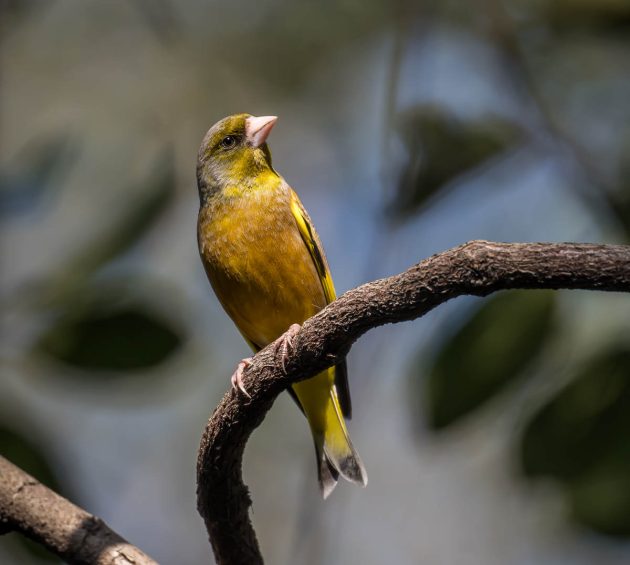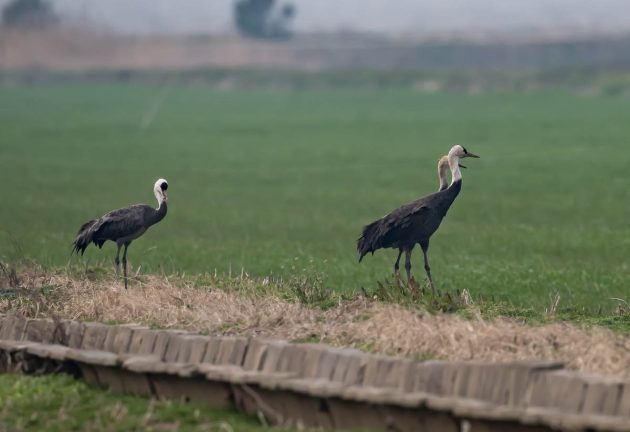Birding Shanghai has its own specific annoyances apart from birds not showing up. One is the continuing destruction of much of its environment. Any place that used to be good for an interesting species last year is likely to have been turned into another construction site this year. The other is that more and more places are closed to the public, jealously guarded by black-clad, Mussolini-inspired watchmen who without any hint of irony tell you that a specific place is privately owned despite the fact that private land ownership does not exist in this supposedly socialist country. Finally, there are specific restrictions for foreigners – I guess we might steal some vital state secrets that have some kind of relationship with the local birds.
But anyway, Shanghai in March. A few changes happen in March – for example, many European countries and the USA switch to daylight savings time. On Chongming Island, some birds change their first names – in particular, the Northern Lapwings change their names to Grey-headed Lapwings.
Grey-headed Lapwings are listed as Least Concern, which is a bit puzzling as the species used to be classified as Near Threatened, and the HBW does not sound too positive about their population size and development: “Previously considered Near Threatened. Population, excluding Japan, numbers less than 10,000–25,000 birds, and probably decreasing”.

Grey Herons flaunt their beauty quite openly (I am still thinking of Gustav Klimt when seeing the patterns on the wings) …


… while other birds like Black-crowned Night Herons show their beauty a bit more carefully.

Tianmashan had two interesting birds in March. One, a Ryukyu Minivet.

The scientific name tegimae honors Seiichi Tegima (1850-1918), a Japanese educationalist, bureaucrat, and museum director. I don’t think many other bird species are named after Japanese citizens.

Tegima was a key figure in establishing the Japanese pavilion at the 1893 World’s Columbian Exposition in Chicago (source). After his arrival in Chicago in preparation for the exhibition, he was featured in Arthur’s Home Magazine, Vol 62 (which to me does not sound like the most thrilling publication in the world) and described as “a most courtly, elegant gentleman, who, except on occasions of extreme ceremonial, appeared in European costume. He was wined and dined at the Chicago clubs and in the most exclusive homes.”

I kind of like birds named after nasty guys (makes for better stories), but Tegima (also named Tejima, see here) was not one of them. He was a strong promoter of technical education and one of the founders of a women’s university. Really not much fun to write about good guys.
Until recently, the Ryukyu Minivet was considered a subspecies of the Ashy Minivet, and indeed the differences from that species – as described in the HBW – seem relatively subtle. Also, there are quite some variations within each species – for details, see here. The author of that paper proudly states “This work, relying on a relatively large data set, considerably improves our understanding of the geographic pattern in morphometric variation in Pericrocotus spp. in northeast Asia.”

While range-restricted, it is apparently common on Ryukyu Island – but a rare sight here in Shanghai.

The other interesting species – also on Tianmashan – was a Verditer Flycatcher. As I did not find any new and interesting information about the species, I did what everybody does these days – I asked ChatGPT. It seems to be impressed by the species: “The Verditer Flycatcher (Eumyias thalassinus) is a strikingly beautiful bird found in South Asia.” And concludes “Overall, the Verditer Flycatcher is not only admired for its stunning appearance but also plays an important ecological role as an insect predator in its native habitats.”

Bonus birds on Tianmashan: Grey-capped Greenfinch …

… a species that – while described by eBird as gregarious – seems to prefer nesting in obscurity, with the three factors of environmental concealment, nest location concealment, and nest location inaccessibility listed as the main nest location selection criteria in a paper …

… and Black-throated Bushtit. This is one of my favorites among cute birds – but that is just my personal opinion. So, again I asked ChatGPT a question: “Is the Black-throated Bushtit a cute bird?”

ChatGPT first replies in a slightly evasive manner but then gets almost annoyingly positive:

“Opinions on whether the Black-throated Bushtit is cute may vary depending on personal preferences and perspectives. However, many people find this bird adorable due to its small size, fluffy appearance, and lively behavior. With its distinctive markings and sociable nature, it often captivates birdwatchers and nature enthusiasts alike.”

Personally, I am a bit worried that once absolutely everyone uses ChatGPT, sentences such as “captivates birdwatchers and nature enthusiasts alike” will become even more common than they already are.
The number of Hooded Cranes on Chongming is thinning out …

… and there also seem to be fewer Eurasian Spoonbills.


They still mix with Black-faced Spoonbills, which otherwise would presumably feel rather lonely given their low global numbers.

I am sure some people will hate this photo of a Eurasian Hoopoe, framed as it is by human artifacts. Of course, me being me, this is a good reason to show it.

As I am sure I have mentioned before, a lot of science work seems to aim to prove the obvious – though the researchers still phrase their results very carefully. For example, here is a statement based on research on the Goldcrest (source): “These results suggest that the ability to deposit fat in the face of an energetically demanding migration may be affected by an individual’s state of health.” Or in my words: If you are sick, it is hard to get fat (but please do not take this as dietary advice).

Another paper – also marginally mentioning goldcrests – describes how different tit species avoid each other, much like I try to avoid other people when birdwatching, if possible:

“Great tits occur only in forests near houses, and the crested tit avoided the foraging sites of the great tit in these forests. The willow tit avoided trees used by the crested tit when both were foraging together. In the best studied case, willow tits moved to outer and upper parts of spruce in the presence of great tits, which forage in lower and inner parts, but in the presence of crested tits, which prefer upper and outer parts of trees, willow tits moved to inner and lower sections of spruce.”
Aren’t we all at least a little bit fascinated by psychology? So, when looking at papers on the Eurasian Siskin, I was happy to find one with the title “Antipredator behavioral compensation of proactive personality trait in male Eurasian Siskins“.

Apparently, male siskins that have a larger black bib are more proactive, which makes them more prone to predation. However, they compensate by being more vigilant when feeding, thus compensating for the increased risks. The authors (who presumably think of themselves as proactive as well) conclude that the proactive males are “not reckless”.

Somewhat similarly, male Eurasian Siskins – which are much brighter colored than the females – also in general show greater vigilance than the females, presumably as compensation for their higher visibility

Little Grebes are already becoming a bit more attractive than in mid-winter …

… while Pied Avocets look perfect all year round anyway.

A few photos of species that I can’t think of writing anything interesting right now …
Yellow-bellied Tit


Reed Parrotbill


Daurian Redstart


Silver-throated Bushtit

Yellow-throated Bunting

Little Bunting (somewhat surprisingly not eating seed despite the winter season)

Oriental Magpie (potentially contributing to China’s real estate issues by adding another nest)

Common Moorhen

Siberian Rubythroat ( admittedly not a perfect example, but still)

… and an old favorite of mine, White’s Thrush.

And to end the post, some raptors, never a very common sight in Shanghai.
Eurasian Sparrowhawk

Based on one paper, one might recommend this female to breed in a city as apparently urban nesters have higher breeding success (though admittedly, that paper looked at rural vs. urban in Scotland, not China).

Something similar seems to apply to the Northern Goshawk: “… goshawks appear to thrive in some urban environments, most likely as a result of high local availability of profitable pigeon prey. We conclude that the Northern Goshawk can be classified as an urban exploiter in parts of its distribution.” (source).

Finally, there is the Eastern Marsh Harrier. As there are rarely any marshes in urban areas, I guess this species better stays outside of the cities.

Thanks to Paul for the help with getting information on Mr. Tegima.
Source link

